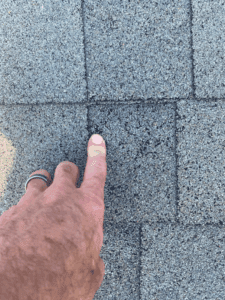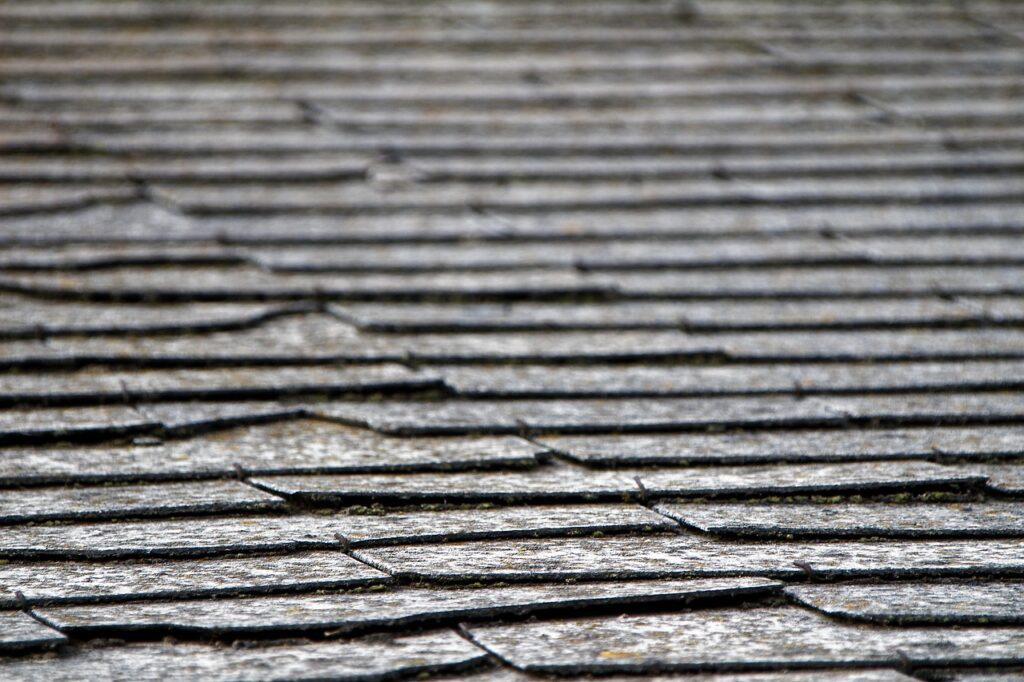Key Takeaways:
- Shingle roofs deteriorate over time from continuous weather exposure.
- Roofs should be inspected routinely to identify various types of shingle damage.
- Call Alliance Roofing for immediate repairs to keep the damage from advancing.
Do you know how to identify roof damage? Can you tell when shingles have started to curl or when there’s granule loss on shingles? Over time, shingles wear down from prolonged weather exposure, and when you know how to spot these issues early, you can have them fixed in time before they progress.
Keep reading to discover different types of shingle damage and how to identify them.
Signs Your Shingle Roof Might Be in Trouble in North Carolina
The most common issues are:
Blistering
A blister is a bump or bubble that forms when high temperatures heat up the moisture or air trapped under the shingle surface. It’s a pretty common type of shingle damage in North Carolina, especially in the summer when temperatures rise up to the mid-90s. As the roof continues to heat up, the bubbles eventually pop.
Blister rupture compromises the integrity of the roofing by creating a weak point that allows the progressive erosion of the protective layer of ceramic granules and lets water through the shingle.
Missing Granules

Granule erosion is also a common type of shingle damage on North Carolina roofs. As mentioned above, weather can create weak points that become the epicenter of granule loss. However, shingles can also lose granules from the impact of heavy raindrops and hail.
North Carolina’s hail season typically runs from March through July, and in that period, hailstones can get up to an inch in diameter. They cause considerable damage wherever they land, whether on the roofs, siding, or vehicles. On shingles, they dislodge the granules, accelerating shingles’ degeneration.
Granule loss on shingles appears as ‘bald spots.’
Curling Shingles
Shingles curl when their corners lift and turn backwards, as though they’re peeling from the roof. There are many causes of this type of shingle damage. At the core is poor roof ventilation, where the roof traps moisture and heat in the attic, causing the shingles to expand and then contract when the temperatures cool down. With time, they start to deform and their edges curl.
Old roofs nearing the end of life also tend to curl, but this can also happen to newer roofs that were not installed correctly. Additionally, shingles curl if they are defective—it starts as soon as they are installed.
Cracked or Split Roof Shingles

Cracking and breaking is also a common type of shingle damage that the Alliance Roofing team encounters as we inspect and maintain roofs across the region. High temperatures cause shingles to expand, and the subsequent cooler weather causes them to contract. As this exchange is repeated over time, shingles lose their ability to withstand temperature variations and eventually crack or split.
Just like shingles without a protective surface due to granule loss, broken shingles are not effective barriers against the elements either, and soon, the roof starts to leak.
Blown-Off Shingles
Windstorms are a common occurrence across North Carolina, and unfortunately, they’re not friendly to shingle roofs. Older roofs are particularly prone to wind damage, and with only a short-lived gust of wind, you may end up with empty spots on your roof.
Since it’ll likely be during the rainy season, have the empty spots repaired right away because they become entry points for water that could damage the roofing materials and underlying roof structure.
How To Handle Any Type of Shingle Damage
Your next course of action after seeing any signs of damage on your roof, whether curling shingles, cracked shingles, granule loss on shingles, or any other roofing problem, is to call Alliance Roofing. We are a team of roofing installation and repair experts with over 20 years of roofing experience and excellent workmanship. We’re based in Wilson, but extend our residential and commercial roofing services to surrounding counties.
Contact us anytime, and we’ll get to you the next day (or the same day) to fix the roofing issue with care and expertise. Even if you’re not sure about the types of shingle damage you’ve seen, we’ll come in, conduct a thorough free roof inspection, and advise on what to do. Don’t risk your roof – Call now for a next-day inspection.
Shingle Damage FAQs
How long will a shingle roof last?
With proper maintenance, it should last 15-30 years.
Can damaged shingles be covered up with new shingles?
Yes, but only if there’s one layer underneath.
How often should I inspect my shingles roof?
Once every year, or after major weather events. It’s best to call in our professional roof inspectors because they’re trained to spot damage that’s not so obvious.
